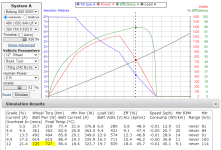rickjames8
1 µW
Hey all - I recently moved from the US to France and have moved to a very walkable town. There are two places I go where I'd like to take a scooter from time to time, so I bought myself a used 36v 500W i9-Max scooter. However, there is one huge hill to get to those destinations. At the steepest bit, it's a 11% grade for about 150 meters, and I'm 190lbs, so it doesn't quite get me up the hill.
So I looked into upgrading the motor, but based on what I was able to search on in this forum, upgrading the motor would mean replacing too many parts and at that point it would be cheaper just to build something else. Which is what I was looking into, when an idea occurred to me.
Could I just add just a second (rear) motor to the i9 Max? It has a front-mount 36v 500w motor. I'd just add a 36v 250w-ish rear motor. Here's why I think it might work. I don't need to speed-control it as I don't need it to be in sync with the front wheel. I'd never ride them both at the same time, except for the 3 minutes or so that I need to get a little kick going up the portion of the big hill. So I'd actually just hook the motor up to the battery using a heavy duty relay, and kick it in with a pushbutton switch. Like the e-scoooter equivalent of adding a nitrous button. If I understand the risk, it's the potential to burn out the motor. But at €50 for a used motor, I'm willing to risk it. Are there other reasons why this would not work?
So I looked into upgrading the motor, but based on what I was able to search on in this forum, upgrading the motor would mean replacing too many parts and at that point it would be cheaper just to build something else. Which is what I was looking into, when an idea occurred to me.
Could I just add just a second (rear) motor to the i9 Max? It has a front-mount 36v 500w motor. I'd just add a 36v 250w-ish rear motor. Here's why I think it might work. I don't need to speed-control it as I don't need it to be in sync with the front wheel. I'd never ride them both at the same time, except for the 3 minutes or so that I need to get a little kick going up the portion of the big hill. So I'd actually just hook the motor up to the battery using a heavy duty relay, and kick it in with a pushbutton switch. Like the e-scoooter equivalent of adding a nitrous button. If I understand the risk, it's the potential to burn out the motor. But at €50 for a used motor, I'm willing to risk it. Are there other reasons why this would not work?
Last edited:



